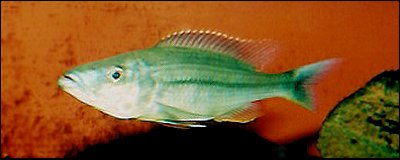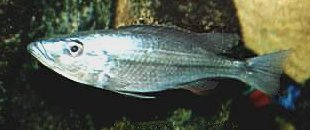

Above: This male Dimidiochromis dimidiatus was photographed in exporter Stuart Grant's house in Malawi, by Danish aquarist Carsten K. Larsen. Carsten very kindly gave permission for his photos of this rarely seen species to be used here. (You may wish to explore Carsten's site, MalawiCarsten, which has photos of several of Lake Malawi's invertebrates, among other interesting features.)
Dimidiochromis dimidiatus is more elongate than its three congeners,
D. strigatus, D. compressiceps,
and D. kiwinge. Like the other members of its genus, D. dimidiatus is predatory,
and looks the part — it has a heavy, deep lower jaw and chin, and the outer teeth in
both jaws are widely spaced, unicuspid, and caninelike (at least once the fish attains about
75 mm or 3 inches in total length). Indeed, it is quite similar in anatomy and color pattern
to the less-specialized members of the genus Rhamphochromis such as
R. macrophthalmus, and I would not be surprised if
D. dimidiatus proved to be the sister-group of the genus Rhamphochromis.
Females (such as, probably, the fish in Carsten Larsen's photo at right) and
juvenile males are plain silvery, except for the narrow midlateral stripe as in males.
(This narrow stripe, incidentally, gives the fish both its generic and its specific names;
"dimidiatus" means "divided in the middle," i.e., divided into two equal parts, as this
stripe divides the flanks of the fish into upper and lower sections.)
Although some color is evident in the young male in the photo at the top of this page, especially
in the dorsal and anal fins, the breeding coloration of males apparently has not been described
or illustrated. Mr. Larsen provided notes on the coloration of a male that is attaining its
adult coloration: "I have a 'small' male (10cm) who is beginning to show colours. A bit more
than the one in Stuart's tank [photo at top of page]. The colours are 'typically'
Dimidiochromis: red anal fin with eggspots, yellow abdomen, and beginning to show blue
on the head" (C.K. Larsen in litt. 8 Jul 2002).
In Lake Malawi, D. dimidiatus inhabits sandy shores, sometimes with plants. It is
thought to be more common in the north. Little is known of its biology.
Jackson (1961: 576) states that it "...is omnivorous but largely
carnivorous, feeding on invertebrates and fish," and gives the maximum known (total?)
length as 26.5 cm (10.4 inches). No indigenous name seems to be recorded for this species.
As an aquarium fish, Dimidiochromis dimidiatus would require a substantial tank, probably
one of around 500 L or 90 gallons when adult. Photographic documentation of the male breeding
colors would be a welcome contribution to our sketchy understanding of this species.


Last Update: 18 July 2005
Web Author: M. K. Oliver, Ph.D.
Copyright © 1997-2021 by M. K. Oliver, Ph.D. - ALL RIGHTS RESERVED